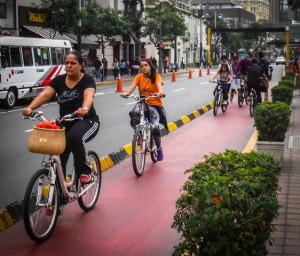
Perseid Press has recently released a book I wrote which deals with my misadventures while living and working in Lima, Peru between 2001 and 2009. I’ve been living in the US for the last five years, but I try to get back to Lima whenever I can. Now with a couple of infant children in tow, Lima is much different than it used to be, although sometimes I wonder if my own changing perspective has resulted in the perceived evolution. The one thing I know for sure is that the Lima I wrote about has almost ceased to exist.
Back in 2009 all the Facebook experts were talking about how the housing crash in Lima was imminent. Buildings were going up like crazy and constructors kept jacking up the prices at what everyone assumed was an unsustainable rate. You’d hear people say things like, “I’m thinking of buying, but I’m waiting for the market to crash so I can get a deal.” Folks who said that are still waiting. Amusingly enough, the guys who were smugly declaring the upcoming crash in 2009 are still offering up unsolicited advice to the next flock of suckers that steps onto the Jorge Chavez tarmac (some things never change I guess, as much as you might want them to).
As you walk around Miraflores or San Isidro, the number of new buildings is staggering. Dining prices are significantly higher than they used to be. I remember getting a steak dinner with salad, potato and wine for S/. 17.50. These days you’re lucky to find a similar meal for twice that.
In the last few years, rent has doubled in Miraflores and it’s 10 times what it was when I moved here in 2001. I’m pleased about that one though because it means the property owners I met early in my travels are doing extremely well these days—assuming they weren’t swindled into selling their property for a fraction of its actual value.
One change that I’m really happy with is the new bike lane that runs along Larco. Lima is a city that is perfect for cycling. Back in the old days, I’d walk rather than take public transit whenever I could. The stop/start driving of combis is enough to make even an iron stomach go a little green, and I’ve never considered myself as having an iron stomach. Wouldn’t a silent Lima with no vehicles and…gasp…no car alarms be wonderful? The only sound you’d hear would be the occasional ring of a bike bell? The introduction of a bike path is a far cry from that exalted fantasy, but it’s a step in the right direction.
Lima needs the bike paths, because the automotive traffic is becoming unreal. I don’t think it’s a matter of perception that the streets seem to be jammed with vehicles these days. Small side streets that used to see very little traffic have suddenly been converted into major thoroughfares. Back in 2009 the naysayers noted that the infrastructure of Lima would have a hard time supporting a major population influx, and they appear to have been correct on that one.
Subway, Popeye’s and Starbucks have taken over, although Domino’s is shut down because of a cockroach. I’ve never understood why in a city with as rich a gastronomic foundation as Lima, people would submit to paying twice as much money for trash food. If there’s one thing Americans know how to do, it’s create propaganda I guess.
Movie theaters assign your seats now, as if we all needed just that little extra bit of needless control in our lives. I don’t know about the rest of you, but if there’s no purpose served in regulating me, then don’t do it. Also, if you’re assigning seats and there are only two people in the theater, please don’t put person #2 directly behind person #1.
One thing that can’t be emphasized enough is that Lima is much safer now, and that’s a good thing. On my first trip in 2001, the US embassy was attacked with a car bomb. These days I feel safe walking the streets with my two infant children.
It truly is remarkable to witness what has been happening in Lima throughout the last decade. For those fortunate enough to live here full time, the change might not be as apparent, but this city is transforming at an astonishing rate. Compare the differences in Lima over the last ten years to the differences in a place like Chicago. In 2001, Lima was its own unique little microcosm, but now it’s starting to take on the aspect of the other major metropolitan hubs of the world. Nostalgia makes me lament some of the changes, but overall it’s clear to see that the evolution is to the advantage of Lima and Peru. If things keep changing at their current rate, who can predict what the Lima of 2025 will be like? Maybe I’ll revisit those Facebook experts and see what genius predictions they offer?
About the Author

Walter Rhein is the author of Reckless Traveler and Beyond Birkie Fever. He also publishes the Streets of Lima blog.
Thanks for posting!
Lima it’s very insecure nowadays, thieves assault you armed and police does nothing, real state has brought a mafia of extortionist formed by many construction workers…. there’s also a trend for using adolescents as hired hitmans or ‘marcas’ to commit crimes against entrepreneurs…. our government of course does nothing…. traffic it’s insane…. it’s a shame that we don’t have subways or any other form of modern transportation on important avenues as other big cities have…. (we only have 1 metro!) …… I’ve been living here my whole life and the only thing that’s ‘better’ is that… we have more american fast-food chains now and…. departments stores… fashion brands…. etc.
Oh, come on! When I first came to Lima they used to grab cell phones right out of your hand as you were walking down the street. Now it’s safe to walk around. Also, the embassy got car bombed! There haven’t been any car bombs in a decade. Sure, there are still things that need to be improved, but there has been significant progress. Having lived in Peru AND in other parts of the world, I can tell you that the rate of improvement Peru has shown over the last few years has been astonishing. It’s most assuredly BETTER!
There is no doubt that Lima is undergoing massive change and that the Lima of today is radically different from what it was several decades ago.In the early ’70s, for example, most of Lima’s buildings were only one or two stories tall, and high rise apartment buildings practically didn’t exist. Now, huge and very tall apartment buildings are everywhere and many neighborhoods in Lima look completely different from what they did in the past. Regrettably, many of the beautiful old colonial mansions that could be found in many Lima neighborhoods are becoming increasingly scarce as they are torn down to make may for high rise apartment buildings. This trend is particularly noticeable on avenues like Javier Pardo that used to have many magnificent mansions owned by rich landowners from the past. Now, many of those few that still exist have been bought up by private enterprises or governmental agencies.
Now, in Lima, the presence of American businesses is much more evident. It’s difficult to pass through many neighborhoods without seeing American restaurants such as McDonalds, Burger King, Kentucky Fries Chicken, Chiles, Friday’s, Starbucks, etc.I’m not going to comment on whether that’s a good thing or a bad thing, but if you’re a foreigner from the USA and lust for US style junk food, you’ll have no trouble finding it in Lima.
Traffic in Lima is as terrible as its always been and Limenos still drive like maniacs, but most cars now are fairly new. In the past, it was not uncommon to see very, very old cars everywhere the road that seemed ready to fall apart at any second. You hardly ever see that any more.
With rhe computer age, the world has become much closer and now, like in most other places, the internet is readily available in Lima and you can get your news from back home almost instantaneously. Now, in Lima, movies debut at about the same time as in the USA and you don’t have to wait months to see them like in the past
Now Lima is making major improvements in many of their streets. In general, they still are pretty bad, but they have a lot less potholes than in the past.
As in the USA, reasonable accommodation laws are in effect for the handicapped,, the aged and the infirm. And Peruvians really adhere to these laws. If you are physically challenged, you will never have to wait on any line in Lima, and that goes for governmental offices where you will be the first to enter or be attended to
I seems as though medical treatment is radically improved in Lima. Decades ago amputees were a comon sight, especially among the poor. Now it’s generally a rare sight. Kudos for that
Yet, despite claims that poverty is down, Lima still have massive areas where slums and terrible poverty continue to exist. The rich and middle class still generally fear the poor and still believe that revolutionary change might take place to dispossess them. Walled homes,barbed wire, and electrified fences continue to be very much evident in Lima
One major change in Lima is the absence of ambulantes in the downtown area. In the ’70s, that were everywhere, selling everything and anything that you can imagine. Most seemed to be newly arrived from the mountains and were generally considered to be a nuisance and despised by the middle and upper class people of Lima. Well, you will hardly ever find these people selling stuff in Lima as in the past, much to the relief of the pitucos who still view the Indians from the mountains as an underclass and who still exist as a reactionary force in Lima society.
Public transportation seems improved in Lima. The buses are newer and better than in the past as are the taxis, and Lima now has a pretty good elevated electric train line that rapidly and conveniently can bring a person cross town in a reasonable amount of time. Governmental officials have plans for a subway line ion Lima, but who knows if that will ever become a reality
For the kids, Lima has completely renovated the Parque de las leyendas, its principle zoo and now Lima has a great water park with a great laser light show that shouldn’t be missed. Yes, Lima is a city undergoing great changes. Thank you, Mr Rhein for for introducing your readers to this imprtant subject.